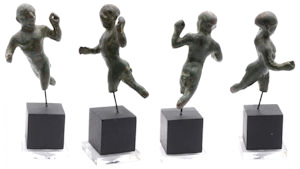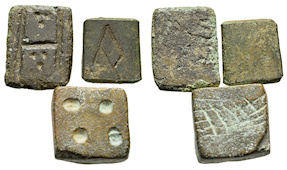Fine Coins Showcase
Antiquities Showcase
Show Empty Categories
Shop Search
Shopping Cart
My FORVM
Contact Us
About Forum
Shopping at Forum
Our Guarantee
Payment Options
Shipping Options & Fees
Privacy & Security
Forum Staff
Selling Your Coins
Identifying Your Coin
FAQs
zoom.asp
Home ▸ Catalog ▸ |Antiquities| ▸ |Antiquities by Material| ▸ |Metal Antiquities||View Options:   | | | | | | Copper was shaped by hammering from early prehistoric times. The Timna Valley in Israel contains evidence of copper mining in 7000 - 5000 B.C. Copper pins, arrowheads, and small personal accouterments date from this time, and it was not long until these gave way to chisels, axes, needles, and larger tools. Ötzi the Iceman found in the Alps in 1991, dated to about 3300 B.C., was found with a copper axe. |



AA99522. Bronze figurine of a bald and naked grotesque athletic dwarf in a rotating movement, exaggerated genitals misplaced at the back side, 7.5 cm tall (10.5 cm with included custom stand), green patina, legs broken, devices once possibly held in both hands now missing, c. 1st century B.C. - 1st century A.D.; ex Gorny & Mosch auction 260 (18 Dec 2018), lot 118; ex D.W. Collection, purchased in Munich c. 1980; very rare; $1620.00 (€1522.80)
Roman, Bronze Krater Handle Ornamented with Lions, c. 1st - 3rd Century A.D.


Click here to see the line drawing of Catalogue des bronzes antiques de la Bibliothèque National no. 1446, a nearly identical handle in the Bibliothèque nationale de France published in 1895.AM23903. Roman bronze krater handle; cf. BnF Bronzes 1446, Superb, about as made with the addition of an an attractive green patina, c. 1st - 3rd Century A.D.; 12 cm (4 7/8") tall, on the upper part, which would have been attached atop the rim of the vessel: a lion's head faces inward, its back arching above, between two lions lying in opposite directions, on the lower part: acanthus and scrolls between two snakes with heads upward, ex Griffin Gallery of Ancient Art (Boca Raton FL); $1600.00 (€1504.00)
Phoenician, Bronze Trapezoid Cube Weight (Ayin - 21.595g), c. 7th - 4th Century B.C.



This weight is the usual shape for the type, an inverted truncated pyramid - a cube with the bottom slightly smaller than the top. The type dates from perhaps as early as the the 9th century B.C. to the end of the Persian period. They were undoubtedly used to weigh silver bullion for transactions. Kletter lists nine weights with circle marks, ranging from 2.55g to 80.67g. Some, like ours, were incised with straight lines or punches. Most were found at Akko.AS111486. Phoenician, bronze trapezoid cube weight; cf. Hendin Weights 245 (21.63), Kletter 2000 25 (21.17g), Hecht A 47 (20.03g), Choice, 21.595g (3 shekels?), 14.3x16.6x12.9mm, c. 7th - 4th Century B.C.; inverted truncated pyramid (a cube with the bottom slightly smaller than the top), incised circle (Phoenician ayin) on top created with a 8 short straight line cuts, ex Shick Coins (Max Shick, Israel, 2012); $500.00 (€470.00)
Byzantine, Lead Bulla Seal, c. 6th Century A.D.


Reading a block monogram of such complexity as on the present Byzantine seal can be maddening, like a quadratic or more complex polynomial equation whose solutions are all found to be reasonable. The inherent ambiguity of many block monograms may have been one reason why they fell out of favor during the seventh century A.D. Nevertheless, through patient study, some possible clues have been squeezed out of ours. The monogram may in fact combine a personal name with the office of a bishop (written in the genitive, EΠICKOΠOY, or "of the bishop") or perhaps even an archbishop (APXIEΠICKOΠOY). The person's name is a much trickier question with multiple possibilities, including Markou, Mariou, Marianou, Maurikiou, Eukarpiou, or even Kyprianou (all transliterated into English in genitive form). Another, less probable, possibility is an unidentified eparch (bishop of an eparchy or diocese).BZ114045. Lead bulla (tag seal), cf. Zacos BLS 1208 (for very similar obv.); DOCBS BZS.1951.31.5.3062 (for similar seal with block monogram), Choice gVF, attractive, yellow oxide patina, weight 10.259 g, maximum diameter 22.1 mm, die axis 330o, c. 6th century A.D.; obverse facing bust of Virgin Hodeghetria, nimbate, wearing tunic and maphorion, holding infant Christ on her left arm/shoulder, nimbate, wearing tunic and himation, dove (i.e., the Holy Spirit) above, cross pattée behind; reverse complex block monogram, containing the letters A, Y, E (lunate), I, K, Π, Ο, P, C, and M and/or X, and possibly N; extremely rare; $200.00 (€188.00)
Roman, Bronze Figural Chest Hasp (Herm), 1st - 4th Century A.D.


To learn about Roman padlocks, Roman chest locks, Roman door locks, and similar Roman chest hasps, see Donald| Jackson's Roman| Gallery| of Locks| Keys| & |Seals in NumisWiki.AS111507. Bronze small chest hasp; cf. Jackson Roman Locks type 1, 5118, Collectible, missing hing loop at back of the top and lock bolt or bolt slot slot at the back of the base, 5.47 cm (2 1/8") long, crude figure in the form of a herm, incised hair and facial features, five punched annulets (Celtic circles) on chest, male genitalia at the midsection; ex The Time Machine (Mark E. Reid); $180.00 (€169.20)
Mediterranean Region, Lead Shell Weight, 1/8 Libra (47.803g), c. 4th Century B.C. - 2nd Century A.D.


Hendin lists several such shell-shaped weights. They are found throughout the Mediterranean Region.AS112213. Lead weight, cf. Hendin Weights 276, Manns-Kloetzli p. 22, 37; Alvarez-Burgos P29, aVF, bumps, weight 24.009 g, maximum diameter 25.1 mm, 4th century B.C. - 2nd century A.D.; 1/8 Libra lead weight molded from bipod shell; $130.00 (€122.20)
Late Roman-Byzantine, 3 Bronze Coin Weights, c. 4th - 11th Century A.D.


H (8) three pellet triangle at base and another above crossbar, 1.632g, 10.5mm x 13.7mm x 2.2mm, cf. Hendin Weights 369 (round, marked with H, 8 siliqua), ex Ancient Treasures (Plamen Arsoff, Granada Hills, CA, 2011).
A (1), 1.217g, 9.4x10.5x2.0mm, ex Ancient Treasures (Plamen Arsoff, Granada Hills, CA, 2011).
4 pellets, 6.084g, 11.4mm x 11.7mm x 5.8mm, ex Zurqieh Ancient Art (UAE, 2017).AS114568. Bronze Lot, 3 Late Roman-Byzantine coin weights, all Choice, c. 4th - 11th Century A.D.; the actual weights in the photographs; $120.00 (€112.80)
Byzantine, 2 Bronze Square Coin Weights, c. 300 - 900 A.D.


Based on weight, c. 1 gram each, these are 1 scripula weights. Both are labeled with N, believed to indicate Numisma. The expected weight for a numisma is, however, c. 4 grams. Weights like these are exceedingly common with great variation in their actual weight, but we remain perplexed by the conflict between the very low weight of these specimens and their markings.AS43875. 2 Bronze Square Coin Weights, cf. Bendall 103 & 104, Collectible, green patina, each c. 1g, ex Ancient Treasures (Plamen Arsoff, Granada Hills, CA, 2011); $100.00 (€94.00)
Roman, Bronze Vessel Lid, c. 1st Century B.C. - 3rd Century A.D.


This lid would have been attached to the vessel with a chain, as seen on Ceci's Piccoli bronzi del Museo Nazionale di Napoli (New York, 1858)., tav. 1, 13. AM20847. Roman bronze vessel lid, 13.5 cm diameter, green patina, earthen deposits, parts of edge ragged, c. 1st Century B.C. - 3rd Century A.D.; $50.00 (€47.00)
Roman Bronze, Figure of Perseus Holding Head of Medusa, c. 1st - 3rd Century A.D.


King Polydektes commanded Perseus to fetch the head of Medusa. With the help of the gods, Perseus obtained the helmet of Hades, which made him invisible, a reflective shield, and a magical harpa sword. Stealing the single eye of the Graeae, he compelled them to reveal the location of the Gorgones. Perseus approached Medusa as she slept and beheaded her with eyes averted to avoid her petrifying visage. Invisibility protected him from her vengeful sisters. On his journey back to Greece, Perseus came across the Ethiopian princess Andromeda chained to a rock as a sacrifice to a sea-monster. He slew the beast and brought her with him back to Greece as his bride. He returned to King Polydektes and turned him to stone, before traveling on to his grandfather's kingdom to claim the throne.
Bronzes of Herakles are abundant in the many museum collections reviewed by Forum, but Perseus is missing from most. We did not find any figures similar to this one in the many references checked.AB23901. Roman Bronze, Figure of Perseus Holding Head of Medusa; BnF Bronzes -, Morgan Bronzes -, ROM Metalware -, BMC Bronzes -, Louvre Bronzes -, Choice, green patina, intact except for missing blade and mounting peg on left foot, reverse bronze standing figure of Perseus, 13cm (5") tall, nude but for the Phrygian helmet of Hades on his head, holding Medusa's head by the hair in his right hand, his harpa (blade missing) in his left hand, stand provided; ex Griffin Gallery of Ancient Art (Boca Raton FL); rare; SOLD
CLICK HERE TO SEE MORE FROM THIS CATEGORY - FORVM's PRIOR SALES



REFERENCES
Page created in 1.657 seconds.








